Report on Mining Methods and Processing: Autonomous Haulage Technology
VerifiedAdded on 2022/09/05
|11
|2335
|22
Report
AI Summary
This report provides a comprehensive overview of autonomous haulage technology in the mining industry. It explores the advancements in robotic trucks, highlighting their efficiency, safety enhancements, and cost-saving potential. The report delves into key performance indicators (KPIs) such as fleet management, product quality, and cost reduction, demonstrating the effectiveness of autonomous systems. It also discusses the readiness of mines for this technology, outlining various implementation approaches and crucial factors to consider, including workforce impact, process adjustments, and technological requirements. Furthermore, the report addresses dilution control, a critical aspect of mining operations, and examines parameters affecting it, such as orebody delineation and blasting techniques. The report references relevant literature and provides valuable insights into the strategic fit and stakeholder communication necessary for successful autonomous system adoption in mining.
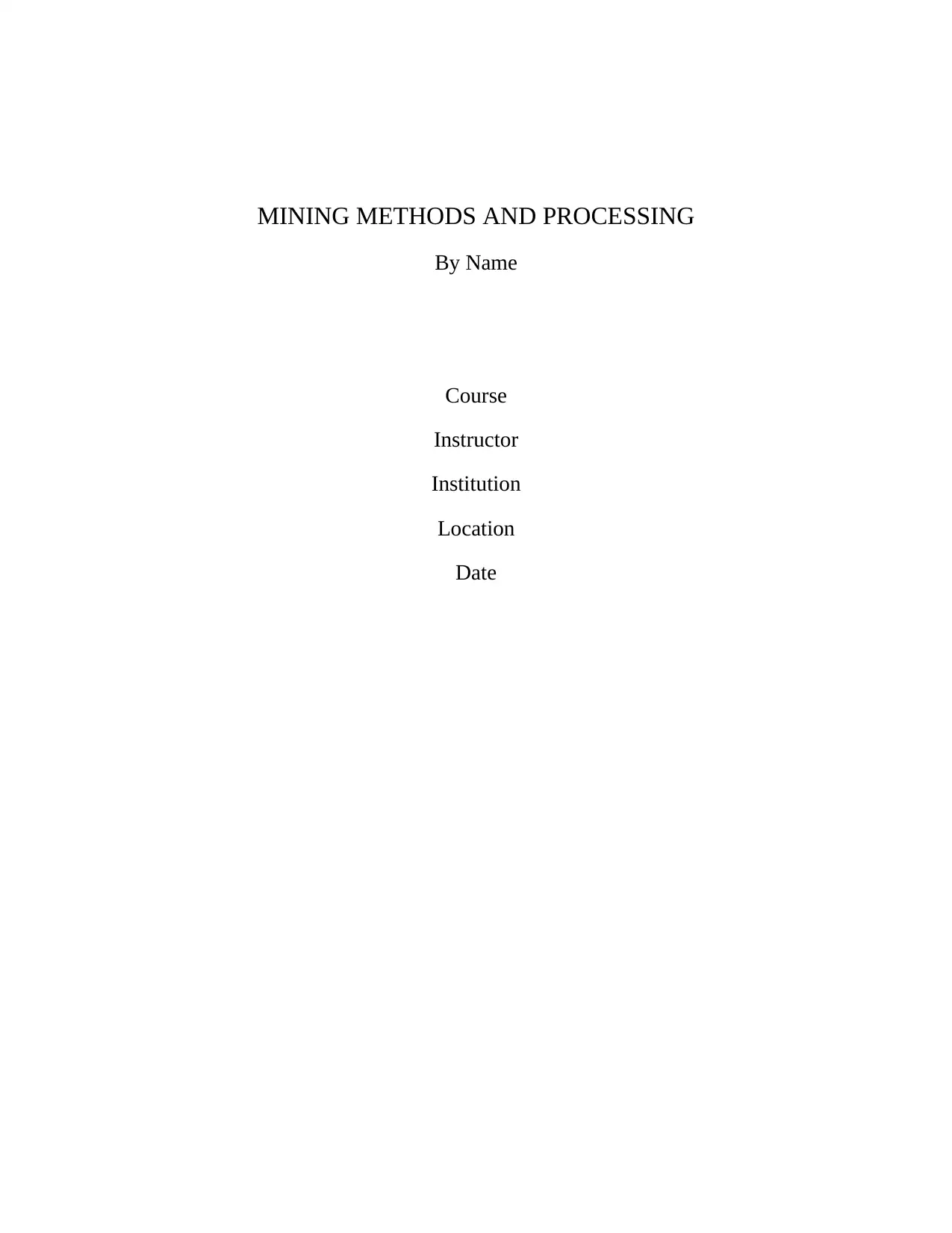
MINING METHODS AND PROCESSING
By Name
Course
Instructor
Institution
Location
Date
By Name
Course
Instructor
Institution
Location
Date
Paraphrase This Document
Need a fresh take? Get an instant paraphrase of this document with our AI Paraphraser
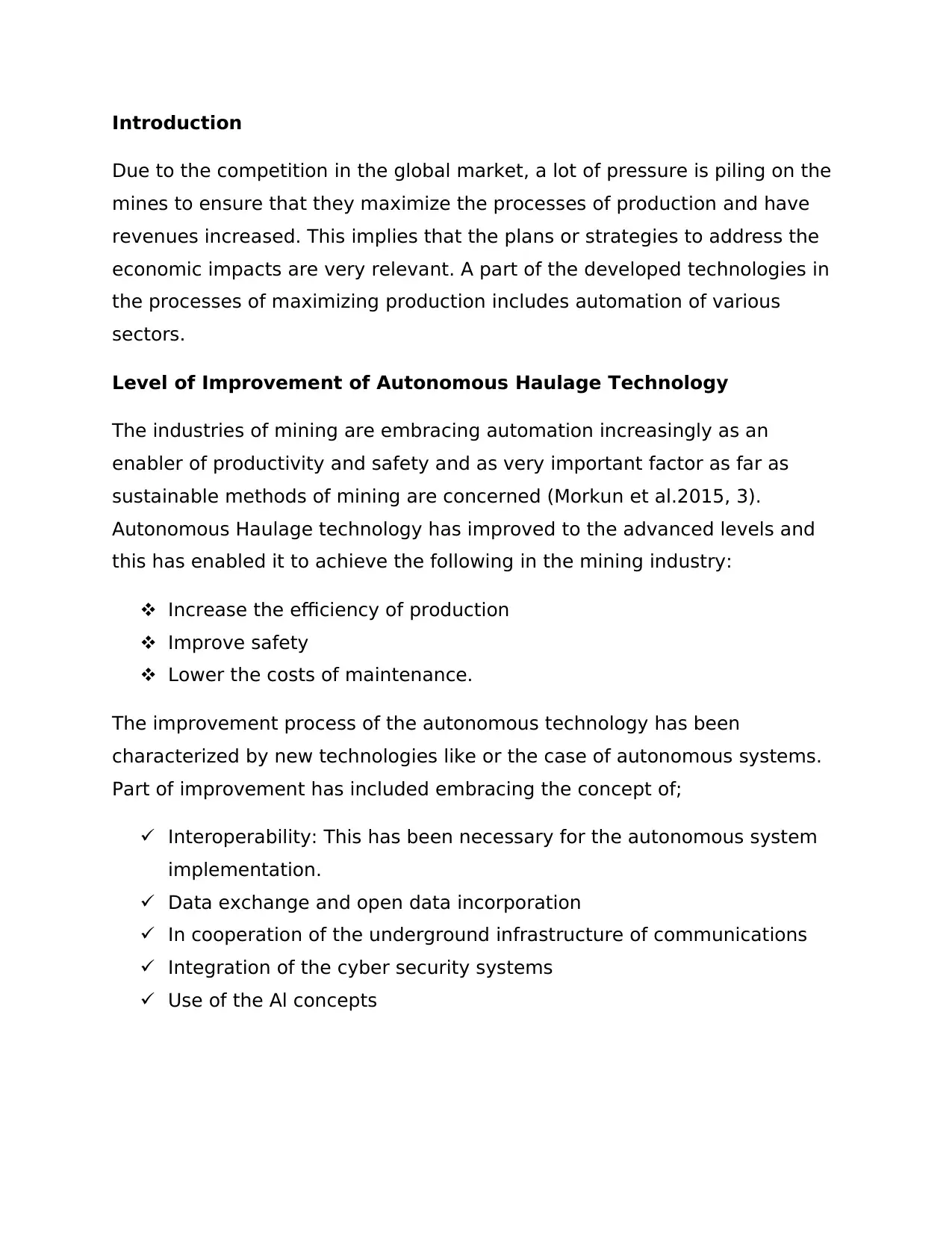
Introduction
Due to the competition in the global market, a lot of pressure is piling on the
mines to ensure that they maximize the processes of production and have
revenues increased. This implies that the plans or strategies to address the
economic impacts are very relevant. A part of the developed technologies in
the processes of maximizing production includes automation of various
sectors.
Level of Improvement of Autonomous Haulage Technology
The industries of mining are embracing automation increasingly as an
enabler of productivity and safety and as very important factor as far as
sustainable methods of mining are concerned (Morkun et al.2015, 3).
Autonomous Haulage technology has improved to the advanced levels and
this has enabled it to achieve the following in the mining industry:
Increase the efficiency of production
Improve safety
Lower the costs of maintenance.
The improvement process of the autonomous technology has been
characterized by new technologies like or the case of autonomous systems.
Part of improvement has included embracing the concept of;
Interoperability: This has been necessary for the autonomous system
implementation.
Data exchange and open data incorporation
In cooperation of the underground infrastructure of communications
Integration of the cyber security systems
Use of the Al concepts
Due to the competition in the global market, a lot of pressure is piling on the
mines to ensure that they maximize the processes of production and have
revenues increased. This implies that the plans or strategies to address the
economic impacts are very relevant. A part of the developed technologies in
the processes of maximizing production includes automation of various
sectors.
Level of Improvement of Autonomous Haulage Technology
The industries of mining are embracing automation increasingly as an
enabler of productivity and safety and as very important factor as far as
sustainable methods of mining are concerned (Morkun et al.2015, 3).
Autonomous Haulage technology has improved to the advanced levels and
this has enabled it to achieve the following in the mining industry:
Increase the efficiency of production
Improve safety
Lower the costs of maintenance.
The improvement process of the autonomous technology has been
characterized by new technologies like or the case of autonomous systems.
Part of improvement has included embracing the concept of;
Interoperability: This has been necessary for the autonomous system
implementation.
Data exchange and open data incorporation
In cooperation of the underground infrastructure of communications
Integration of the cyber security systems
Use of the Al concepts
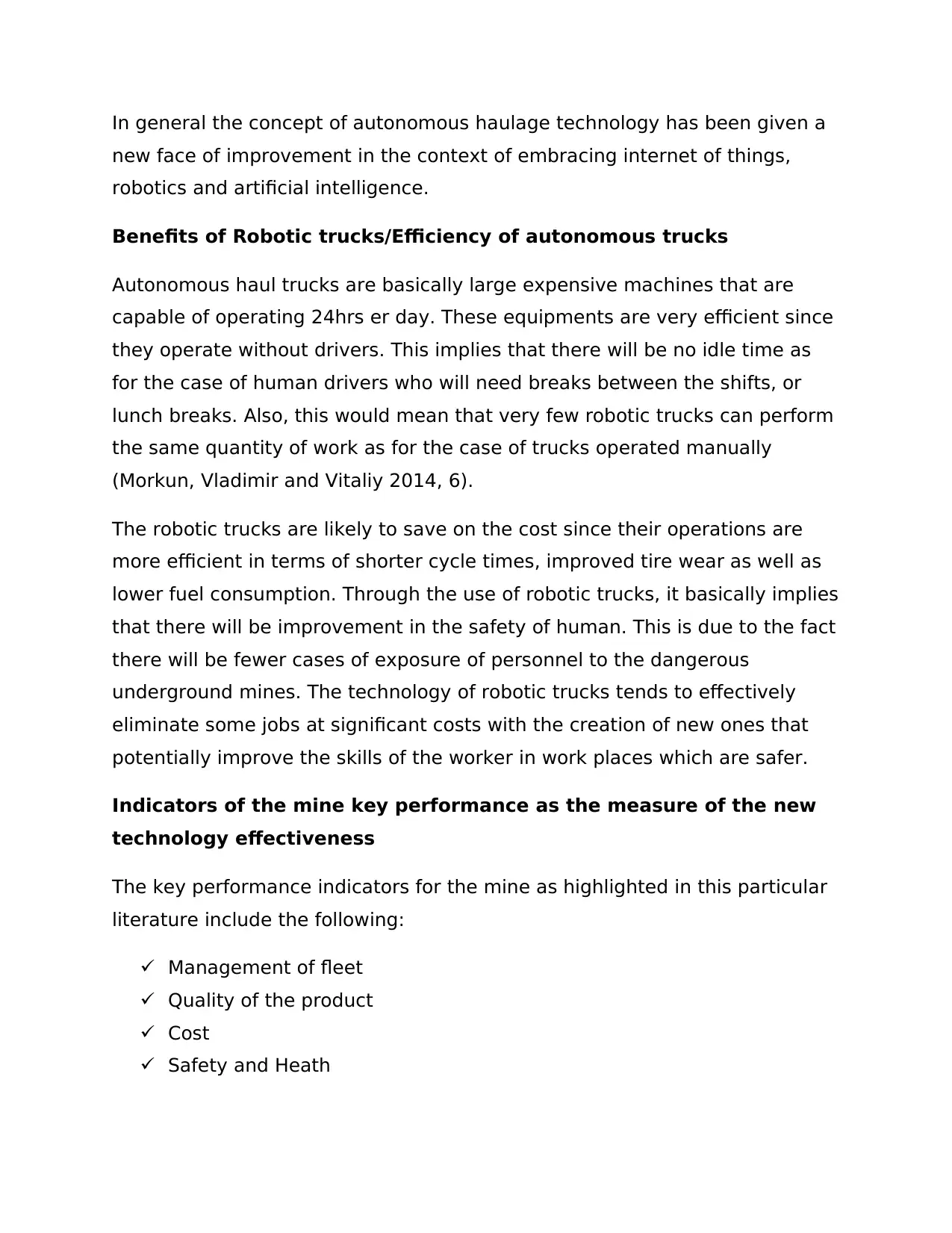
In general the concept of autonomous haulage technology has been given a
new face of improvement in the context of embracing internet of things,
robotics and artificial intelligence.
Benefits of Robotic trucks/Efficiency of autonomous trucks
Autonomous haul trucks are basically large expensive machines that are
capable of operating 24hrs er day. These equipments are very efficient since
they operate without drivers. This implies that there will be no idle time as
for the case of human drivers who will need breaks between the shifts, or
lunch breaks. Also, this would mean that very few robotic trucks can perform
the same quantity of work as for the case of trucks operated manually
(Morkun, Vladimir and Vitaliy 2014, 6).
The robotic trucks are likely to save on the cost since their operations are
more efficient in terms of shorter cycle times, improved tire wear as well as
lower fuel consumption. Through the use of robotic trucks, it basically implies
that there will be improvement in the safety of human. This is due to the fact
there will be fewer cases of exposure of personnel to the dangerous
underground mines. The technology of robotic trucks tends to effectively
eliminate some jobs at significant costs with the creation of new ones that
potentially improve the skills of the worker in work places which are safer.
Indicators of the mine key performance as the measure of the new
technology effectiveness
The key performance indicators for the mine as highlighted in this particular
literature include the following:
Management of fleet
Quality of the product
Cost
Safety and Heath
new face of improvement in the context of embracing internet of things,
robotics and artificial intelligence.
Benefits of Robotic trucks/Efficiency of autonomous trucks
Autonomous haul trucks are basically large expensive machines that are
capable of operating 24hrs er day. These equipments are very efficient since
they operate without drivers. This implies that there will be no idle time as
for the case of human drivers who will need breaks between the shifts, or
lunch breaks. Also, this would mean that very few robotic trucks can perform
the same quantity of work as for the case of trucks operated manually
(Morkun, Vladimir and Vitaliy 2014, 6).
The robotic trucks are likely to save on the cost since their operations are
more efficient in terms of shorter cycle times, improved tire wear as well as
lower fuel consumption. Through the use of robotic trucks, it basically implies
that there will be improvement in the safety of human. This is due to the fact
there will be fewer cases of exposure of personnel to the dangerous
underground mines. The technology of robotic trucks tends to effectively
eliminate some jobs at significant costs with the creation of new ones that
potentially improve the skills of the worker in work places which are safer.
Indicators of the mine key performance as the measure of the new
technology effectiveness
The key performance indicators for the mine as highlighted in this particular
literature include the following:
Management of fleet
Quality of the product
Cost
Safety and Heath
⊘ This is a preview!⊘
Do you want full access?
Subscribe today to unlock all pages.

Trusted by 1+ million students worldwide
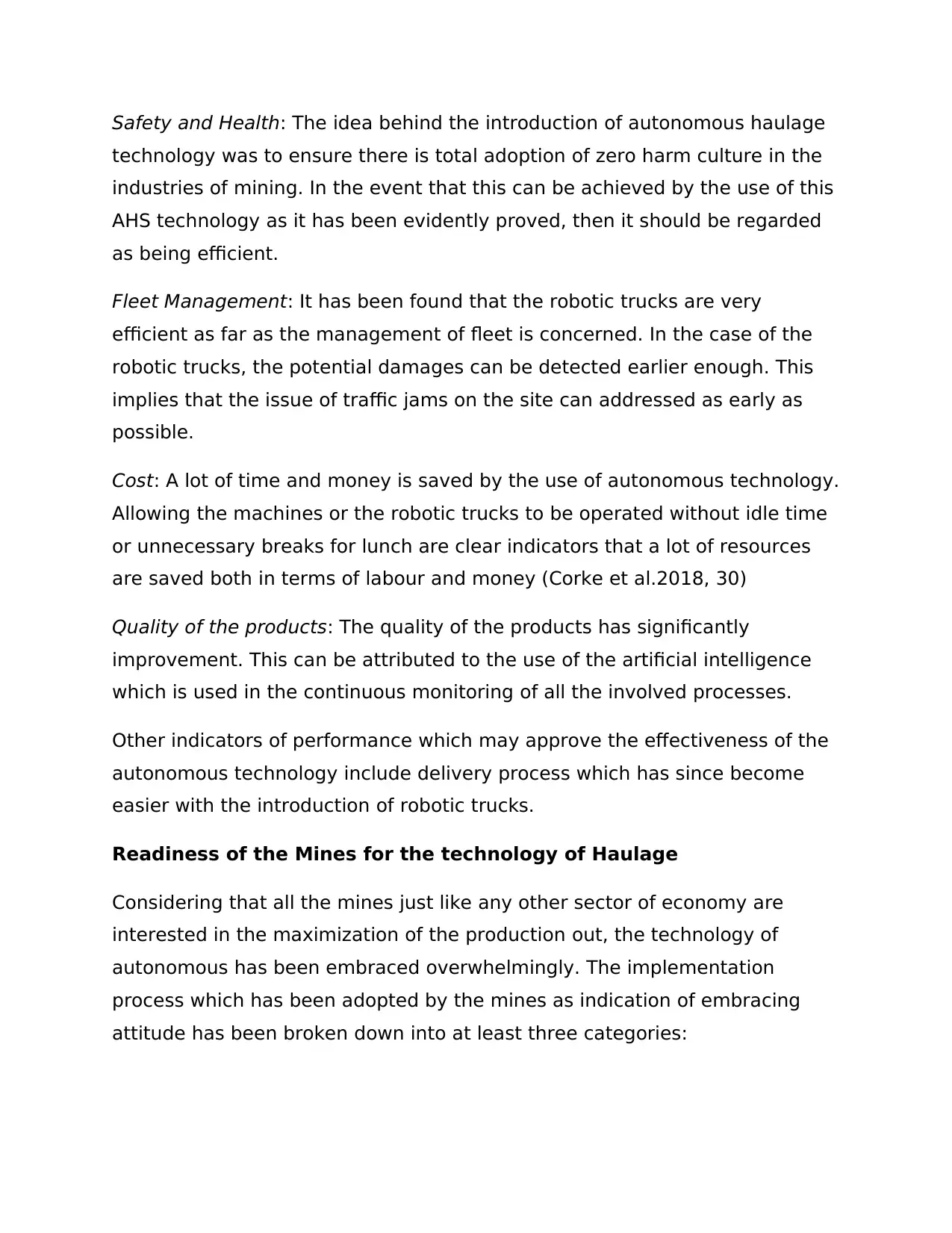
Safety and Health: The idea behind the introduction of autonomous haulage
technology was to ensure there is total adoption of zero harm culture in the
industries of mining. In the event that this can be achieved by the use of this
AHS technology as it has been evidently proved, then it should be regarded
as being efficient.
Fleet Management: It has been found that the robotic trucks are very
efficient as far as the management of fleet is concerned. In the case of the
robotic trucks, the potential damages can be detected earlier enough. This
implies that the issue of traffic jams on the site can addressed as early as
possible.
Cost: A lot of time and money is saved by the use of autonomous technology.
Allowing the machines or the robotic trucks to be operated without idle time
or unnecessary breaks for lunch are clear indicators that a lot of resources
are saved both in terms of labour and money (Corke et al.2018, 30)
Quality of the products: The quality of the products has significantly
improvement. This can be attributed to the use of the artificial intelligence
which is used in the continuous monitoring of all the involved processes.
Other indicators of performance which may approve the effectiveness of the
autonomous technology include delivery process which has since become
easier with the introduction of robotic trucks.
Readiness of the Mines for the technology of Haulage
Considering that all the mines just like any other sector of economy are
interested in the maximization of the production out, the technology of
autonomous has been embraced overwhelmingly. The implementation
process which has been adopted by the mines as indication of embracing
attitude has been broken down into at least three categories:
technology was to ensure there is total adoption of zero harm culture in the
industries of mining. In the event that this can be achieved by the use of this
AHS technology as it has been evidently proved, then it should be regarded
as being efficient.
Fleet Management: It has been found that the robotic trucks are very
efficient as far as the management of fleet is concerned. In the case of the
robotic trucks, the potential damages can be detected earlier enough. This
implies that the issue of traffic jams on the site can addressed as early as
possible.
Cost: A lot of time and money is saved by the use of autonomous technology.
Allowing the machines or the robotic trucks to be operated without idle time
or unnecessary breaks for lunch are clear indicators that a lot of resources
are saved both in terms of labour and money (Corke et al.2018, 30)
Quality of the products: The quality of the products has significantly
improvement. This can be attributed to the use of the artificial intelligence
which is used in the continuous monitoring of all the involved processes.
Other indicators of performance which may approve the effectiveness of the
autonomous technology include delivery process which has since become
easier with the introduction of robotic trucks.
Readiness of the Mines for the technology of Haulage
Considering that all the mines just like any other sector of economy are
interested in the maximization of the production out, the technology of
autonomous has been embraced overwhelmingly. The implementation
process which has been adopted by the mines as indication of embracing
attitude has been broken down into at least three categories:
Paraphrase This Document
Need a fresh take? Get an instant paraphrase of this document with our AI Paraphraser
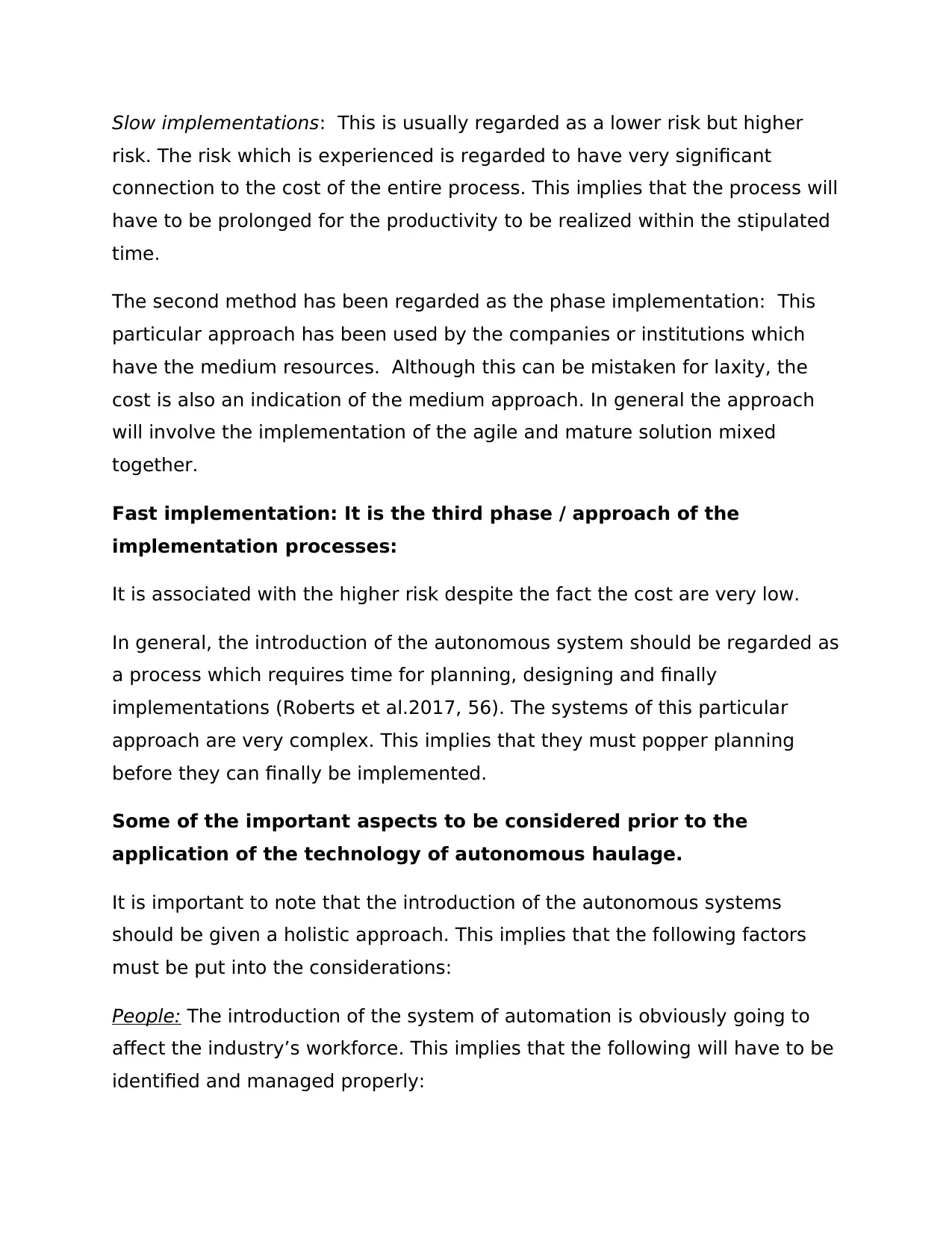
Slow implementations: This is usually regarded as a lower risk but higher
risk. The risk which is experienced is regarded to have very significant
connection to the cost of the entire process. This implies that the process will
have to be prolonged for the productivity to be realized within the stipulated
time.
The second method has been regarded as the phase implementation: This
particular approach has been used by the companies or institutions which
have the medium resources. Although this can be mistaken for laxity, the
cost is also an indication of the medium approach. In general the approach
will involve the implementation of the agile and mature solution mixed
together.
Fast implementation: It is the third phase / approach of the
implementation processes:
It is associated with the higher risk despite the fact the cost are very low.
In general, the introduction of the autonomous system should be regarded as
a process which requires time for planning, designing and finally
implementations (Roberts et al.2017, 56). The systems of this particular
approach are very complex. This implies that they must popper planning
before they can finally be implemented.
Some of the important aspects to be considered prior to the
application of the technology of autonomous haulage.
It is important to note that the introduction of the autonomous systems
should be given a holistic approach. This implies that the following factors
must be put into the considerations:
People: The introduction of the system of automation is obviously going to
affect the industry’s workforce. This implies that the following will have to be
identified and managed properly:
risk. The risk which is experienced is regarded to have very significant
connection to the cost of the entire process. This implies that the process will
have to be prolonged for the productivity to be realized within the stipulated
time.
The second method has been regarded as the phase implementation: This
particular approach has been used by the companies or institutions which
have the medium resources. Although this can be mistaken for laxity, the
cost is also an indication of the medium approach. In general the approach
will involve the implementation of the agile and mature solution mixed
together.
Fast implementation: It is the third phase / approach of the
implementation processes:
It is associated with the higher risk despite the fact the cost are very low.
In general, the introduction of the autonomous system should be regarded as
a process which requires time for planning, designing and finally
implementations (Roberts et al.2017, 56). The systems of this particular
approach are very complex. This implies that they must popper planning
before they can finally be implemented.
Some of the important aspects to be considered prior to the
application of the technology of autonomous haulage.
It is important to note that the introduction of the autonomous systems
should be given a holistic approach. This implies that the following factors
must be put into the considerations:
People: The introduction of the system of automation is obviously going to
affect the industry’s workforce. This implies that the following will have to be
identified and managed properly:
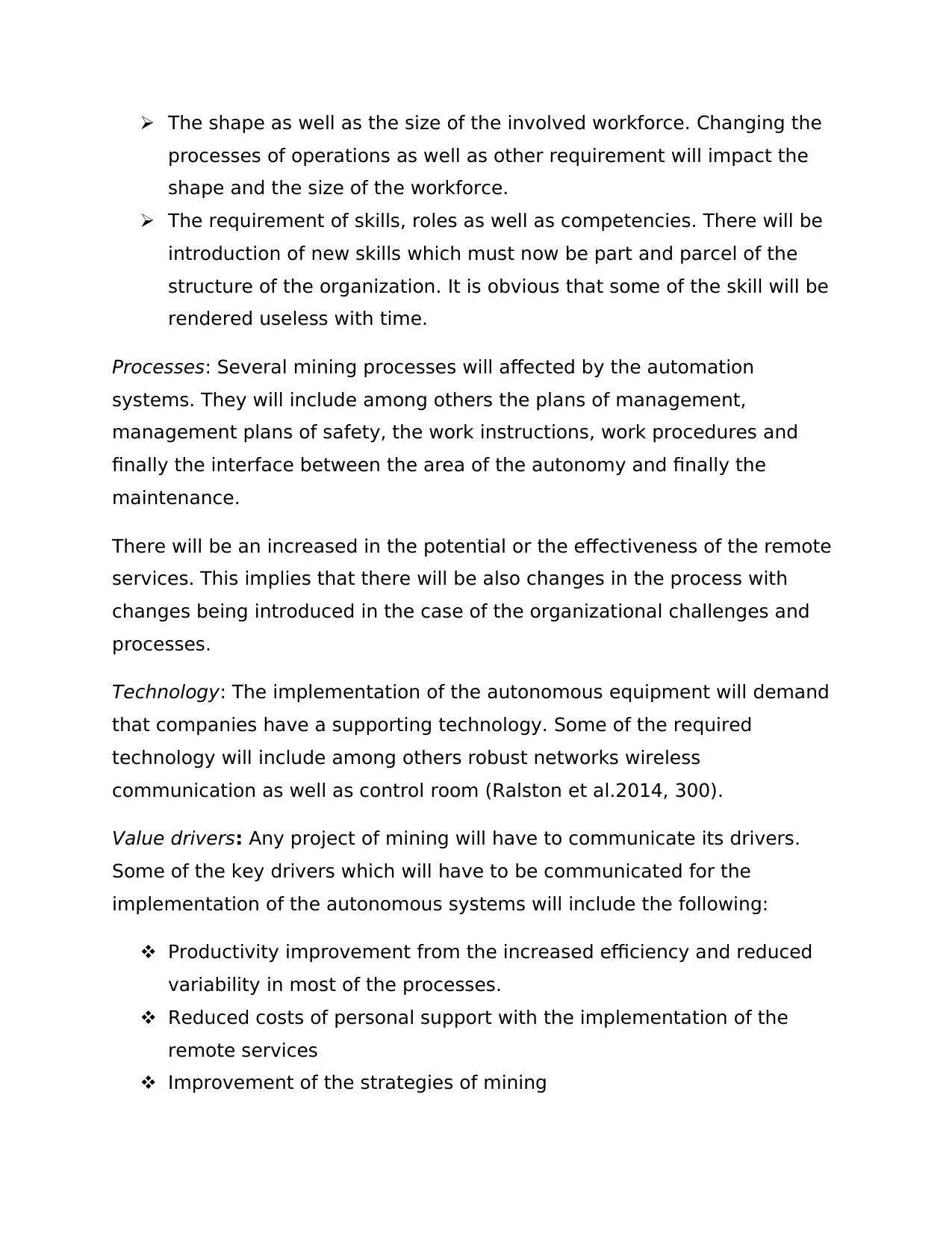
The shape as well as the size of the involved workforce. Changing the
processes of operations as well as other requirement will impact the
shape and the size of the workforce.
The requirement of skills, roles as well as competencies. There will be
introduction of new skills which must now be part and parcel of the
structure of the organization. It is obvious that some of the skill will be
rendered useless with time.
Processes: Several mining processes will affected by the automation
systems. They will include among others the plans of management,
management plans of safety, the work instructions, work procedures and
finally the interface between the area of the autonomy and finally the
maintenance.
There will be an increased in the potential or the effectiveness of the remote
services. This implies that there will be also changes in the process with
changes being introduced in the case of the organizational challenges and
processes.
Technology: The implementation of the autonomous equipment will demand
that companies have a supporting technology. Some of the required
technology will include among others robust networks wireless
communication as well as control room (Ralston et al.2014, 300).
Value drivers: Any project of mining will have to communicate its drivers.
Some of the key drivers which will have to be communicated for the
implementation of the autonomous systems will include the following:
Productivity improvement from the increased efficiency and reduced
variability in most of the processes.
Reduced costs of personal support with the implementation of the
remote services
Improvement of the strategies of mining
processes of operations as well as other requirement will impact the
shape and the size of the workforce.
The requirement of skills, roles as well as competencies. There will be
introduction of new skills which must now be part and parcel of the
structure of the organization. It is obvious that some of the skill will be
rendered useless with time.
Processes: Several mining processes will affected by the automation
systems. They will include among others the plans of management,
management plans of safety, the work instructions, work procedures and
finally the interface between the area of the autonomy and finally the
maintenance.
There will be an increased in the potential or the effectiveness of the remote
services. This implies that there will be also changes in the process with
changes being introduced in the case of the organizational challenges and
processes.
Technology: The implementation of the autonomous equipment will demand
that companies have a supporting technology. Some of the required
technology will include among others robust networks wireless
communication as well as control room (Ralston et al.2014, 300).
Value drivers: Any project of mining will have to communicate its drivers.
Some of the key drivers which will have to be communicated for the
implementation of the autonomous systems will include the following:
Productivity improvement from the increased efficiency and reduced
variability in most of the processes.
Reduced costs of personal support with the implementation of the
remote services
Improvement of the strategies of mining
⊘ This is a preview!⊘
Do you want full access?
Subscribe today to unlock all pages.

Trusted by 1+ million students worldwide
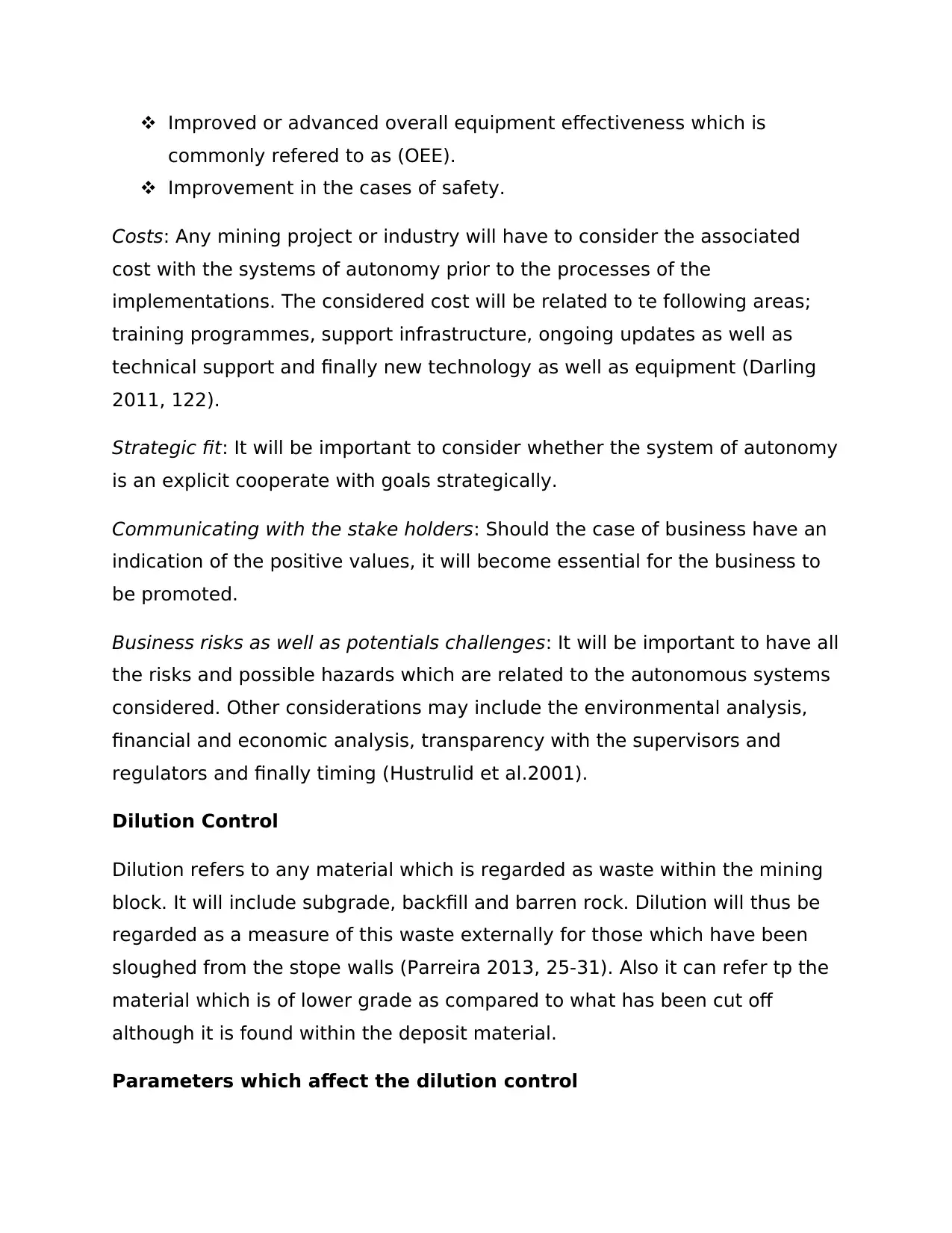
Improved or advanced overall equipment effectiveness which is
commonly refered to as (OEE).
Improvement in the cases of safety.
Costs: Any mining project or industry will have to consider the associated
cost with the systems of autonomy prior to the processes of the
implementations. The considered cost will be related to te following areas;
training programmes, support infrastructure, ongoing updates as well as
technical support and finally new technology as well as equipment (Darling
2011, 122).
Strategic fit: It will be important to consider whether the system of autonomy
is an explicit cooperate with goals strategically.
Communicating with the stake holders: Should the case of business have an
indication of the positive values, it will become essential for the business to
be promoted.
Business risks as well as potentials challenges: It will be important to have all
the risks and possible hazards which are related to the autonomous systems
considered. Other considerations may include the environmental analysis,
financial and economic analysis, transparency with the supervisors and
regulators and finally timing (Hustrulid et al.2001).
Dilution Control
Dilution refers to any material which is regarded as waste within the mining
block. It will include subgrade, backfill and barren rock. Dilution will thus be
regarded as a measure of this waste externally for those which have been
sloughed from the stope walls (Parreira 2013, 25-31). Also it can refer tp the
material which is of lower grade as compared to what has been cut off
although it is found within the deposit material.
Parameters which affect the dilution control
commonly refered to as (OEE).
Improvement in the cases of safety.
Costs: Any mining project or industry will have to consider the associated
cost with the systems of autonomy prior to the processes of the
implementations. The considered cost will be related to te following areas;
training programmes, support infrastructure, ongoing updates as well as
technical support and finally new technology as well as equipment (Darling
2011, 122).
Strategic fit: It will be important to consider whether the system of autonomy
is an explicit cooperate with goals strategically.
Communicating with the stake holders: Should the case of business have an
indication of the positive values, it will become essential for the business to
be promoted.
Business risks as well as potentials challenges: It will be important to have all
the risks and possible hazards which are related to the autonomous systems
considered. Other considerations may include the environmental analysis,
financial and economic analysis, transparency with the supervisors and
regulators and finally timing (Hustrulid et al.2001).
Dilution Control
Dilution refers to any material which is regarded as waste within the mining
block. It will include subgrade, backfill and barren rock. Dilution will thus be
regarded as a measure of this waste externally for those which have been
sloughed from the stope walls (Parreira 2013, 25-31). Also it can refer tp the
material which is of lower grade as compared to what has been cut off
although it is found within the deposit material.
Parameters which affect the dilution control
Paraphrase This Document
Need a fresh take? Get an instant paraphrase of this document with our AI Paraphraser
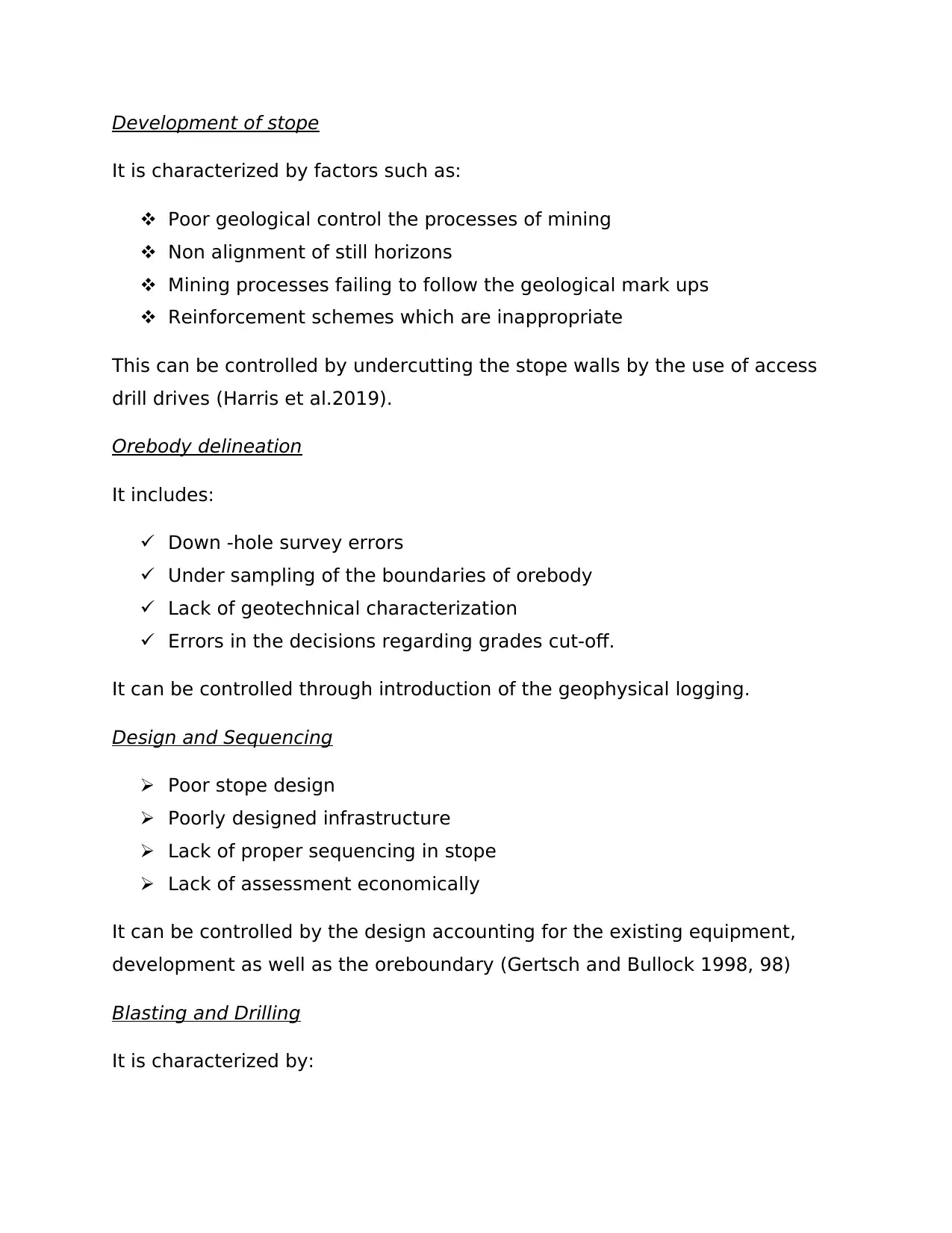
Development of stope
It is characterized by factors such as:
Poor geological control the processes of mining
Non alignment of still horizons
Mining processes failing to follow the geological mark ups
Reinforcement schemes which are inappropriate
This can be controlled by undercutting the stope walls by the use of access
drill drives (Harris et al.2019).
Orebody delineation
It includes:
Down -hole survey errors
Under sampling of the boundaries of orebody
Lack of geotechnical characterization
Errors in the decisions regarding grades cut-off.
It can be controlled through introduction of the geophysical logging.
Design and Sequencing
Poor stope design
Poorly designed infrastructure
Lack of proper sequencing in stope
Lack of assessment economically
It can be controlled by the design accounting for the existing equipment,
development as well as the oreboundary (Gertsch and Bullock 1998, 98)
Blasting and Drilling
It is characterized by:
It is characterized by factors such as:
Poor geological control the processes of mining
Non alignment of still horizons
Mining processes failing to follow the geological mark ups
Reinforcement schemes which are inappropriate
This can be controlled by undercutting the stope walls by the use of access
drill drives (Harris et al.2019).
Orebody delineation
It includes:
Down -hole survey errors
Under sampling of the boundaries of orebody
Lack of geotechnical characterization
Errors in the decisions regarding grades cut-off.
It can be controlled through introduction of the geophysical logging.
Design and Sequencing
Poor stope design
Poorly designed infrastructure
Lack of proper sequencing in stope
Lack of assessment economically
It can be controlled by the design accounting for the existing equipment,
development as well as the oreboundary (Gertsch and Bullock 1998, 98)
Blasting and Drilling
It is characterized by:
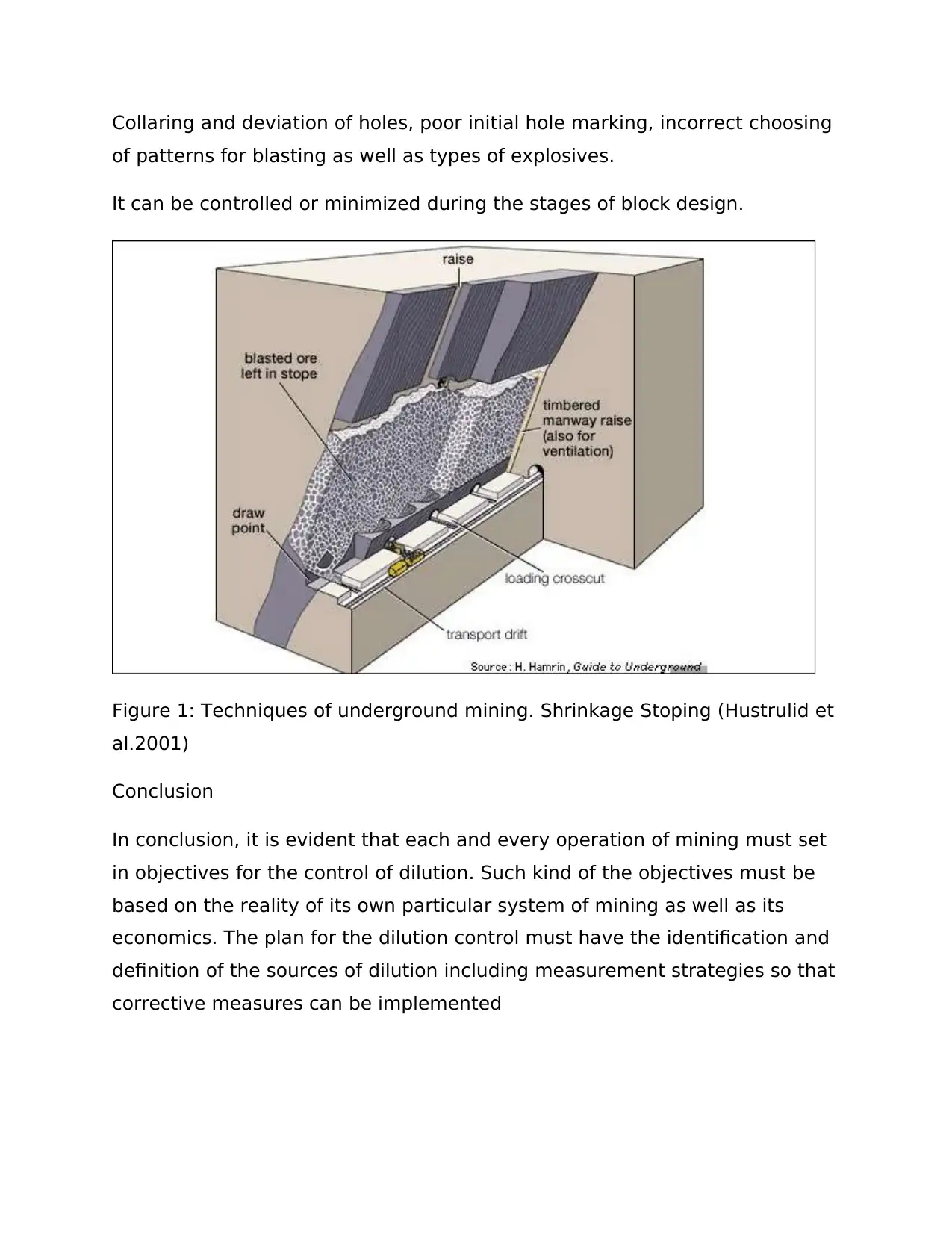
Collaring and deviation of holes, poor initial hole marking, incorrect choosing
of patterns for blasting as well as types of explosives.
It can be controlled or minimized during the stages of block design.
Figure 1: Techniques of underground mining. Shrinkage Stoping (Hustrulid et
al.2001)
Conclusion
In conclusion, it is evident that each and every operation of mining must set
in objectives for the control of dilution. Such kind of the objectives must be
based on the reality of its own particular system of mining as well as its
economics. The plan for the dilution control must have the identification and
definition of the sources of dilution including measurement strategies so that
corrective measures can be implemented
of patterns for blasting as well as types of explosives.
It can be controlled or minimized during the stages of block design.
Figure 1: Techniques of underground mining. Shrinkage Stoping (Hustrulid et
al.2001)
Conclusion
In conclusion, it is evident that each and every operation of mining must set
in objectives for the control of dilution. Such kind of the objectives must be
based on the reality of its own particular system of mining as well as its
economics. The plan for the dilution control must have the identification and
definition of the sources of dilution including measurement strategies so that
corrective measures can be implemented
⊘ This is a preview!⊘
Do you want full access?
Subscribe today to unlock all pages.

Trusted by 1+ million students worldwide
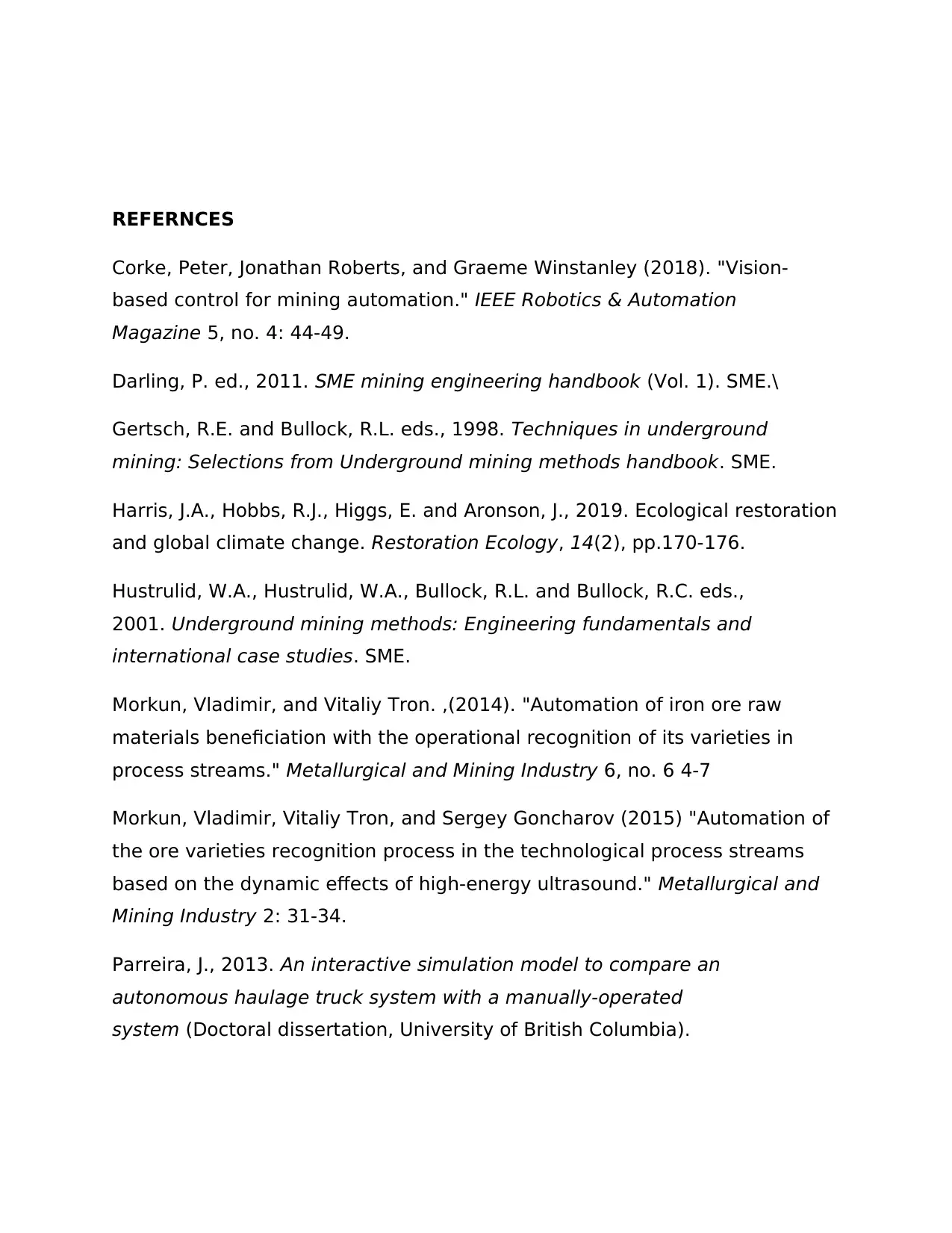
REFERNCES
Corke, Peter, Jonathan Roberts, and Graeme Winstanley (2018). "Vision-
based control for mining automation." IEEE Robotics & Automation
Magazine 5, no. 4: 44-49.
Darling, P. ed., 2011. SME mining engineering handbook (Vol. 1). SME.\
Gertsch, R.E. and Bullock, R.L. eds., 1998. Techniques in underground
mining: Selections from Underground mining methods handbook. SME.
Harris, J.A., Hobbs, R.J., Higgs, E. and Aronson, J., 2019. Ecological restoration
and global climate change. Restoration Ecology, 14(2), pp.170-176.
Hustrulid, W.A., Hustrulid, W.A., Bullock, R.L. and Bullock, R.C. eds.,
2001. Underground mining methods: Engineering fundamentals and
international case studies. SME.
Morkun, Vladimir, and Vitaliy Tron. ,(2014). "Automation of iron ore raw
materials beneficiation with the operational recognition of its varieties in
process streams." Metallurgical and Mining Industry 6, no. 6 4-7
Morkun, Vladimir, Vitaliy Tron, and Sergey Goncharov (2015) "Automation of
the ore varieties recognition process in the technological process streams
based on the dynamic effects of high-energy ultrasound." Metallurgical and
Mining Industry 2: 31-34.
Parreira, J., 2013. An interactive simulation model to compare an
autonomous haulage truck system with a manually-operated
system (Doctoral dissertation, University of British Columbia).
Corke, Peter, Jonathan Roberts, and Graeme Winstanley (2018). "Vision-
based control for mining automation." IEEE Robotics & Automation
Magazine 5, no. 4: 44-49.
Darling, P. ed., 2011. SME mining engineering handbook (Vol. 1). SME.\
Gertsch, R.E. and Bullock, R.L. eds., 1998. Techniques in underground
mining: Selections from Underground mining methods handbook. SME.
Harris, J.A., Hobbs, R.J., Higgs, E. and Aronson, J., 2019. Ecological restoration
and global climate change. Restoration Ecology, 14(2), pp.170-176.
Hustrulid, W.A., Hustrulid, W.A., Bullock, R.L. and Bullock, R.C. eds.,
2001. Underground mining methods: Engineering fundamentals and
international case studies. SME.
Morkun, Vladimir, and Vitaliy Tron. ,(2014). "Automation of iron ore raw
materials beneficiation with the operational recognition of its varieties in
process streams." Metallurgical and Mining Industry 6, no. 6 4-7
Morkun, Vladimir, Vitaliy Tron, and Sergey Goncharov (2015) "Automation of
the ore varieties recognition process in the technological process streams
based on the dynamic effects of high-energy ultrasound." Metallurgical and
Mining Industry 2: 31-34.
Parreira, J., 2013. An interactive simulation model to compare an
autonomous haulage truck system with a manually-operated
system (Doctoral dissertation, University of British Columbia).
Paraphrase This Document
Need a fresh take? Get an instant paraphrase of this document with our AI Paraphraser
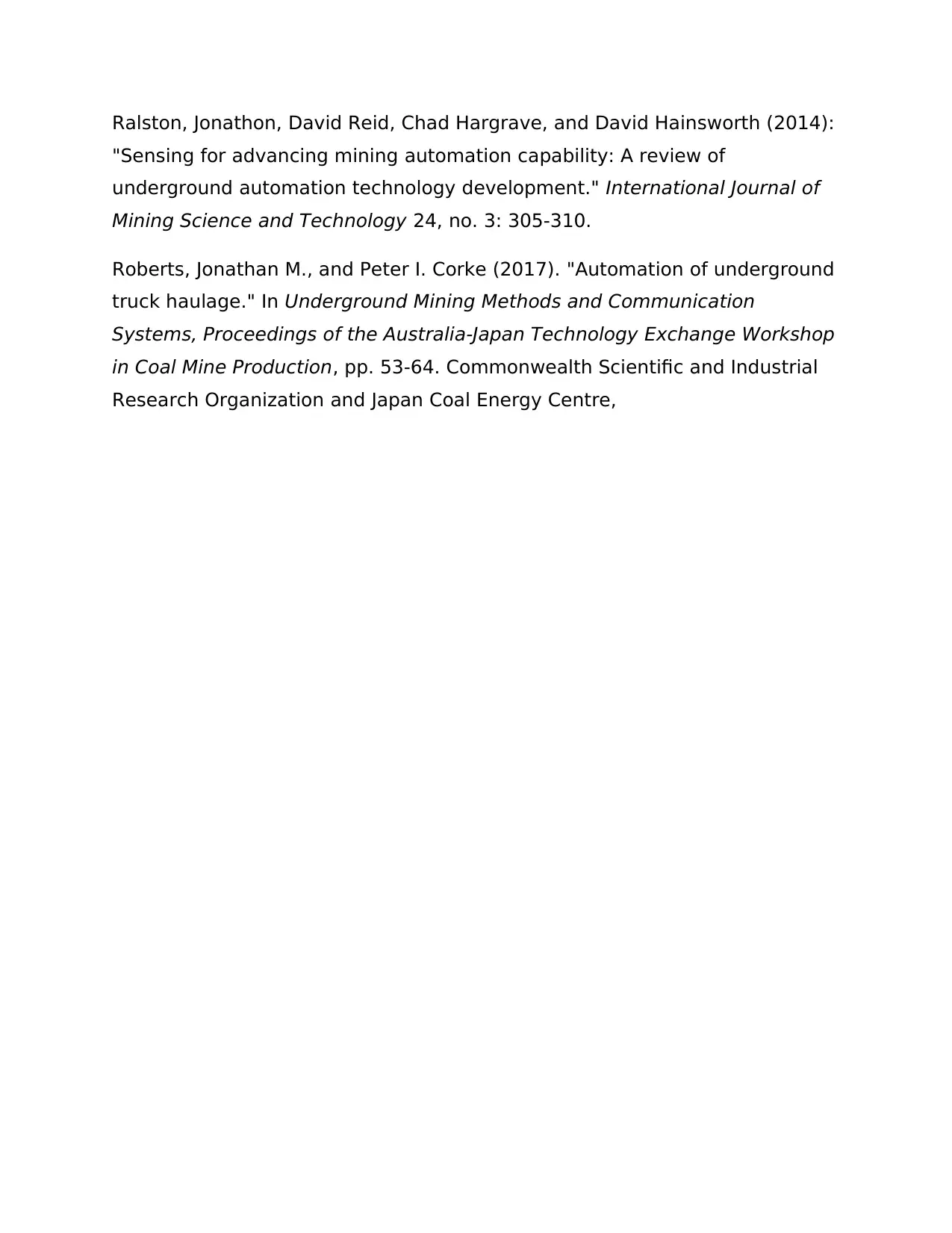
Ralston, Jonathon, David Reid, Chad Hargrave, and David Hainsworth (2014):
"Sensing for advancing mining automation capability: A review of
underground automation technology development." International Journal of
Mining Science and Technology 24, no. 3: 305-310.
Roberts, Jonathan M., and Peter I. Corke (2017). "Automation of underground
truck haulage." In Underground Mining Methods and Communication
Systems, Proceedings of the Australia-Japan Technology Exchange Workshop
in Coal Mine Production, pp. 53-64. Commonwealth Scientific and Industrial
Research Organization and Japan Coal Energy Centre,
"Sensing for advancing mining automation capability: A review of
underground automation technology development." International Journal of
Mining Science and Technology 24, no. 3: 305-310.
Roberts, Jonathan M., and Peter I. Corke (2017). "Automation of underground
truck haulage." In Underground Mining Methods and Communication
Systems, Proceedings of the Australia-Japan Technology Exchange Workshop
in Coal Mine Production, pp. 53-64. Commonwealth Scientific and Industrial
Research Organization and Japan Coal Energy Centre,
1 out of 11
Related Documents
Your All-in-One AI-Powered Toolkit for Academic Success.
+13062052269
info@desklib.com
Available 24*7 on WhatsApp / Email
![[object Object]](/_next/static/media/star-bottom.7253800d.svg)
Unlock your academic potential
Copyright © 2020–2025 A2Z Services. All Rights Reserved. Developed and managed by ZUCOL.





